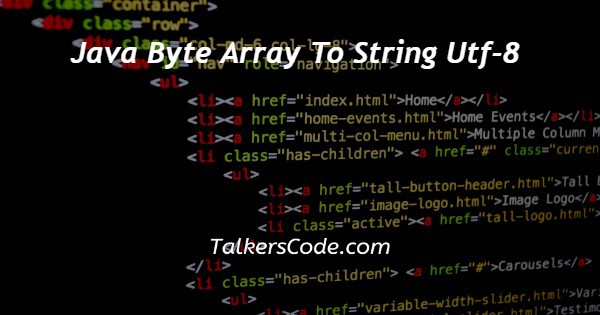In this article we will show you the solution of java byte array to string utf-8, byte arrays are frequently used in Java to hold binary data.
But occasionally, especially when working with text data, we need to turn these byte arrays into strings.
This article tries to give a thorough explanation of how to encode a Java byte array with the UTF-8 encoding format as a String.
To ensure a thorough comprehension of the procedure, we'll examine several approaches and step-by-step breakdowns.
In Java, we will use the String class and the Charset class from the standard library to encode a byte array as a UTF-8 String.
While the String class offers practical methods for converting byte arrays to strings, the Charset class allows us to select the character encoding scheme.
Step By Step Guide On Java Byte Array To String Utf-8 :-
Let's start by taking a look at the fundamental line of code that converts a byte array to a UTF-8 encoded String:
import java.nio.charset.Charset;
public class ByteArrayToStringExample {
public static void main(String[] args) {
byte[] byteArray = {72, 101, 108, 108, 111, 32, 87, 111, 114, 108, 100};
String utf8 String = new String(byteArray, Charset.forName("UTF-8"));
System.out.println(utf8String);
}
}
- To manage character encoding, we import the 'Charset' class from the 'java.nio.charset' package.
- The ASCII values of the characters we want to convert to a String are placed in a "byteArray". This instance contains the byte array for the phrase "Hello World."
- By providing the 'byteArray' and the UTF-8 encoding scheme to the 'String' constructor, a new object with the name 'utf8String' is created.
- To finish, we use the 'System.out.println' statement to print the transformed string.
- To produce strings from byte arrays, the 'String' class offers a number of constructors. The constructor that accepts a byte array and a 'Charset' object as parameters is used in this example.
- By designating "UTF-8" as the character encoding scheme, we guarantee that the byte array will be correctly read as a UTF-8 encoded string.
- The byte array can be used as an ordinary string object in our Java program once it has been transformed to a UTF-8 encoded string.
- We print the transformed string to the console in this instance.
Conclusion :-
We looked at converting a Java byte array to a UTF-8 encoded string in this tutorial.
We can simply do this translation by combining the 'String' and 'Charset' classes.
When working with binary data that needs to be represented as text, knowing how to convert byte arrays to strings is critical.
You should now have a thorough knowledge of how to convert byte arrays to UTF-8 encoded texts in Java if you followed the step-by-step explanation and code provided in this article.
This expertise will come in handy when dealing with various data manipulation chores and communicating with external systems that require binary data string representations.
To ensure appropriate conversion, keep in mind the character encoding scheme utilized in your individual use case.
Also, keep an eye out for any potential exceptions that may arise when dealing with character encoding, such as 'UnsupportedEncodingException'.
I hope this article on java byte array to string utf-8 helps you and the steps and method mentioned above are easy to follow and implement.














